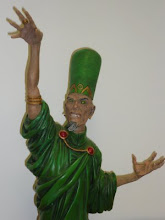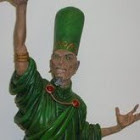 A very engaging and entertaining science fiction noir comic that has an obvious hook that thankfully does not create the problems it could. In a post apocalyptic world a mercenary with a nuclear power robotic arm among other enhancements finds that that a mission leads directly to a confrontation with his one time owners/employers over the future of the planet. A standard story platform that is a standard because it offers so many story possibilities depending on the imagination and discipline of the creative team. Happily for reader Jason Yungbluth has enough imagination and discipline to use this platform in outstandingly creative and inventive ways and applies the genre requirements of both science fiction ans noir fiction to great effect.
A very engaging and entertaining science fiction noir comic that has an obvious hook that thankfully does not create the problems it could. In a post apocalyptic world a mercenary with a nuclear power robotic arm among other enhancements finds that that a mission leads directly to a confrontation with his one time owners/employers over the future of the planet. A standard story platform that is a standard because it offers so many story possibilities depending on the imagination and discipline of the creative team. Happily for reader Jason Yungbluth has enough imagination and discipline to use this platform in outstandingly creative and inventive ways and applies the genre requirements of both science fiction ans noir fiction to great effect.The obvious hook for this story is that is is a parody of the US newspaper comic strips, using well known characters in a variety of brutally inventive ways. The problem this raises right away is that a parody relies on prior knowledge by the reader and frequently induces lazy writing and art as the creative team trade on this assumed knowledge. A parody runs the risk of being an inside joke that is meaningless to those outside the magic circle and tiresome to those within it.Thankfully Jason Yungbluth is for too good a writer and artist to fall into the trap, rather he uses the parody element as a bubbling angry subtext for the full tilt ahead, all reader friendly, story that happens to have an extra element for those who care and of no consequence to those who do not.
For any science fiction story the context is all important, and in Weapon Brown the context is simply fantastic,a genuinely destroyed world with clever currency as everyone left fights for the most important thing left, food. The devastated landscape is powerfully and sometimes playfully created and developed in the book. The details are smart and telling and is where the threads from the comic strips are used as superb starting points. Jason Yungbluth is able to provide an rolling context for the action in a very natural way, the actions of the cast provide the information the reader needs. He avoids any info dumps to set scenes, it comes up as required as the cast interact with each other and the extremely hostile environment. Critically the villains are credibly appalling and with a genuinely forceful motivation rather than just being malignant, their opponents are as mixed as they should be given the circumstances. Surviving means that everyone is making brutal choices, the difference lies in degree and the choices made.
The cast are all fighting for every bit of pace and life available and this gives all of them and the book as a whole a tremendous vitality as everyone is demanding and deserving the readers attention. This makes even the smallest action scene come alive and the relatively few peaceful moments have weight and depth.
The art is a joy, the book clearly took time and the art changes and develops as the book proceeds before settling to an extended style. The changes are never disruptive, they flow easily into each other and are clearly the result of the same controlling imagination and artistic intent. This is where the parody element is used to best effect, by having a established gallery of characters to draw upon a huge and varied cast can be created and the artistic possibilities can be extended. The art captures the ideas of the book with tremendous force and clarity, it takes full advantage of the simplicity of the story platform to give room to details that add physical weight to the context and give the action brutal force.
This is a first class science fiction comic, it uses the unlimited budget of comics with thoughtful abandon to develop and surprise with ideas and locations. It is also a great noir story of a wounded hero who finds that, perhaps, his heart has not died and that hope may not be fatal after all.




